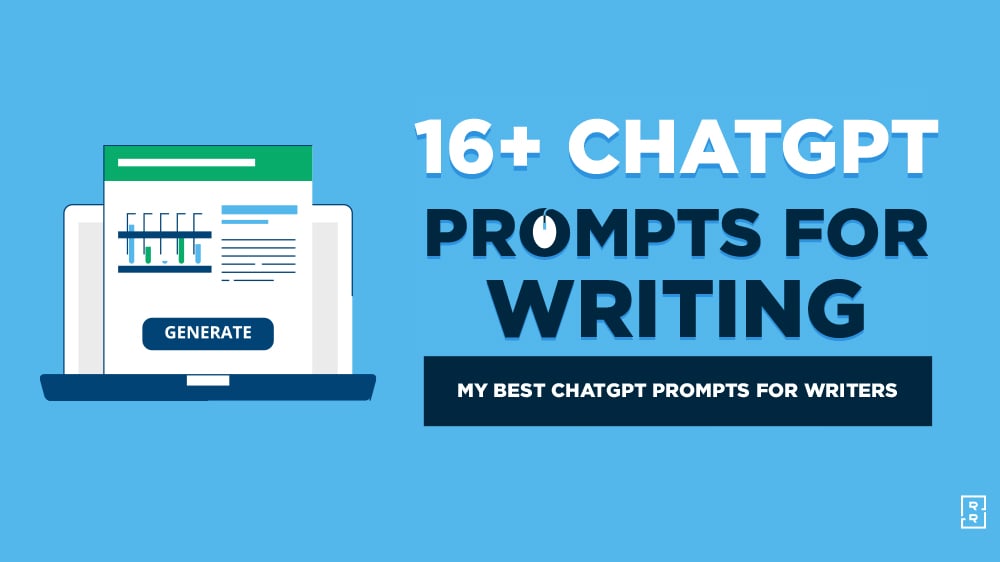I’ve been using AI (and ChatGPT) since it first rolled out and blew all of our collective minds. As a result, I’ve spent literally hours fine-tuning these ChatGPT prompts for writing great content that get me results—ranging from generating entire SEO-optimized blog post drafts, to social copy, content calendars, meta details, and everything in-between.
So without dilly-dallying here, please enjoy my breakdown of all my favorite ChatGPT writing prompts, and what makes for the perfect prompt formula when you go to craft your own prompts:
Let’s dive into each of my ChatGPT writing prompts, one at a time. Real quick though, if you’re anything like me, you like to work smart, not hard. So, I wanna introduce you to my suite of 75+ AI-powered tools for creators, inside RightBlogger (you can create a 100% free account to take all our tools for a spin). These are the tools I wished I had when I first started creating content, built by me.
RightBlogger takes the complex AI prompting out of the equation for you. We handle all that behind-the-scenes, and we’re damn good at it. Thousands of creators, bloggers, marketers, writers, and SEO pros are using our tools instead of ChatGPT—because it simplifies the AI-assisted creation process & allows you to focus on getting results from your content. Come take our tools for a spin with a free account today.
Try RightBlogger: My 75+ Hand-Crafted Tools for Bloggers
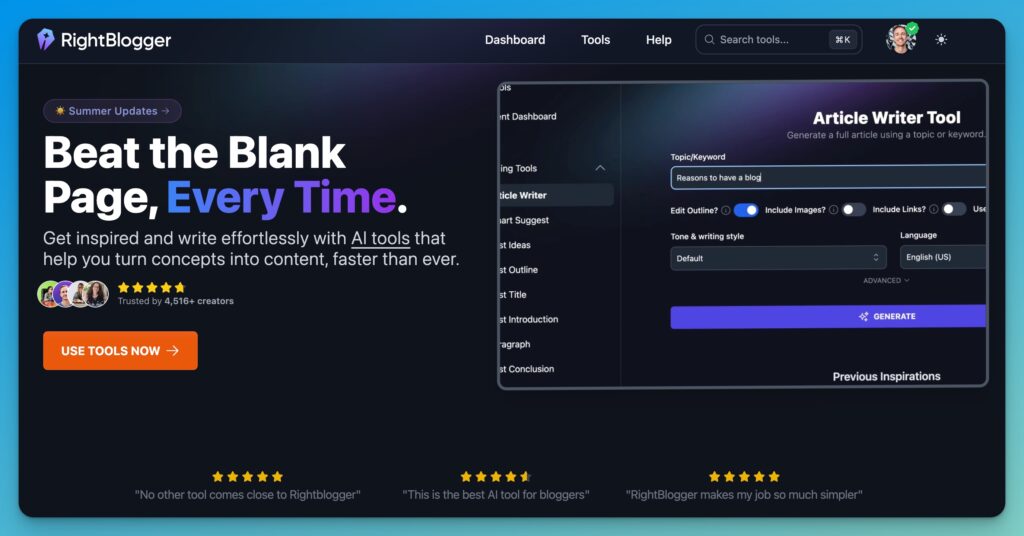

Join 4,516+ creators, bloggers, marketers, writers, freelancers & entrepreneurs in using my very own kit of powerful tools for content creation: RightBlogger. You’ll unlock 75+ blogging, SEO, marketing, sales and productivity-focused tools to create content faster & more effectively today.
Here are all my top ChatGPT prompts for writing, broken down by category, so you can hop around to your heart’s content:
16+ ChatGPT Prompts for Writing (and My AI Prompt Formula)
- Core Writing Components (The Greatest Hits)
- Ideation & Planning
- Research & Opportunity Identification
- SEO-Optimizing, Improving, Repurposing & Promoting
- My AI Prompt Writing Formula
Now, let’s dive right in with my greatest hits—the ChatGPT writing prompts I use (and share) most often.
Core Writing Components: My Fundamental ChatGPT Writing Prompts
One of the best ways to think of ChatGPT, is as a powerful writing assistant. It’s not a replacement for you, and it never will be (because it can’t).
However, AI blogging tools like ChatGPT do a fantastic job of laying a foundation, crafting first draft components, and allowing you to dodge blank page mania for one more day… or steering clear from throwing your typewriter across the room…


Here’s how to use ChatGPT to quickly generate useful first drafts for the core components of your writing—introductions, conclusions, outlines, sections within your articles, full articles, and FAQ content that’ll help you help your audience, faster.
1. Introductions
First up, writing introductions with the help of AI. I don’t know about you, but sometimes I’m just not feeling inspired when I sit down to write. Even if I have the kernel of a good idea, it helps me to get some inspiration on ways I could start my blog post. ChatGPT is great for that.
Here’s my ChatGPT prompt for writing introductions that don’t suck, and give you a great starting point to begin your writing process. I also have a free AI blog introduction writer you can use, too.
You’re an experienced writer with a skill for creating highly engaging blog posts that capture the attention of your audience and deliver value. Write a compelling introduction to a blog post on the topic of [TOPIC] taking into account these key points and important details:
[KEY POINTS AND DETAILS]
When writing the introduction, consider using the PAS framework to state the problem, agitate, and present a preview of the solution that’ll be covered in the blog post to come. Don’t use cheesy terms or tired phrases. Don’t meander, but feel free to use creative storytelling sparingly where appropriate.
Here’s what this ChatGPT writing prompt looks like in action, generating an introduction for a blog post (I need) about meditation tips:
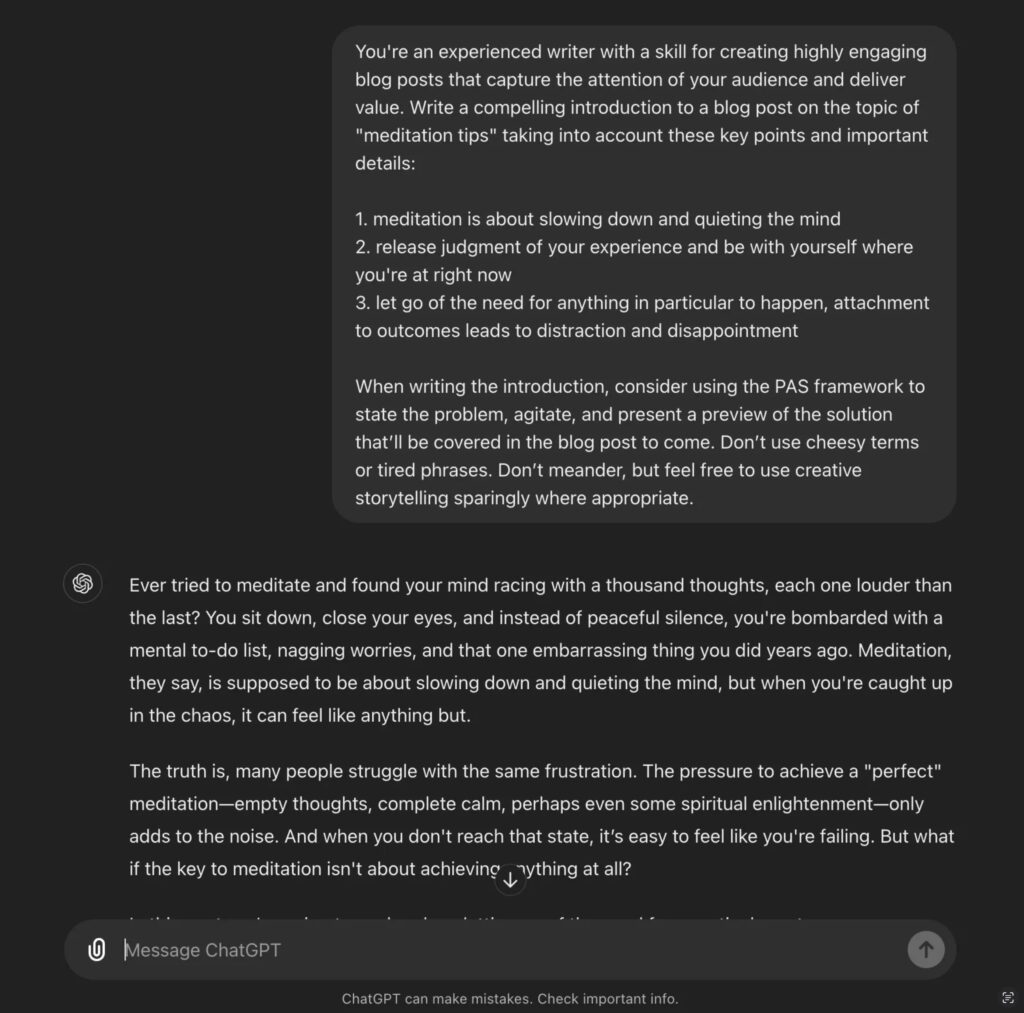

Write first draft introductions in just a few clicks using my free blog introduction writer.
2. Conclusions
All great blog conclusions share one thing in common: they effectively call your reader to action. Someone who makes it to the end of your article, is highly engaged with what you’re sharing. This ChatGPT prompt for writing action-oriented conclusions, will steer you in the right direction, to building deeper relationships with your readers.
You’re an experienced writer with a skill for creating highly engaging blog posts that capture the attention of your audience and deliver value. Write a compelling conclusion to a blog post on the topic of [TOPIC] taking into account these key points and important details that are covered in the post, itself:
[KEY POINTS AND DETAILS]
When writing the conclusion, drive home the main takeaways of the post, and encourage readers to [DESIRED ACTION]. Don’t use cheesy terms or tired phrases. Don’t meander, but feel free to use creative storytelling sparingly where appropriate.
And here’s a preview of what you can expect ChatGPT to do, using this conclusion prompt:
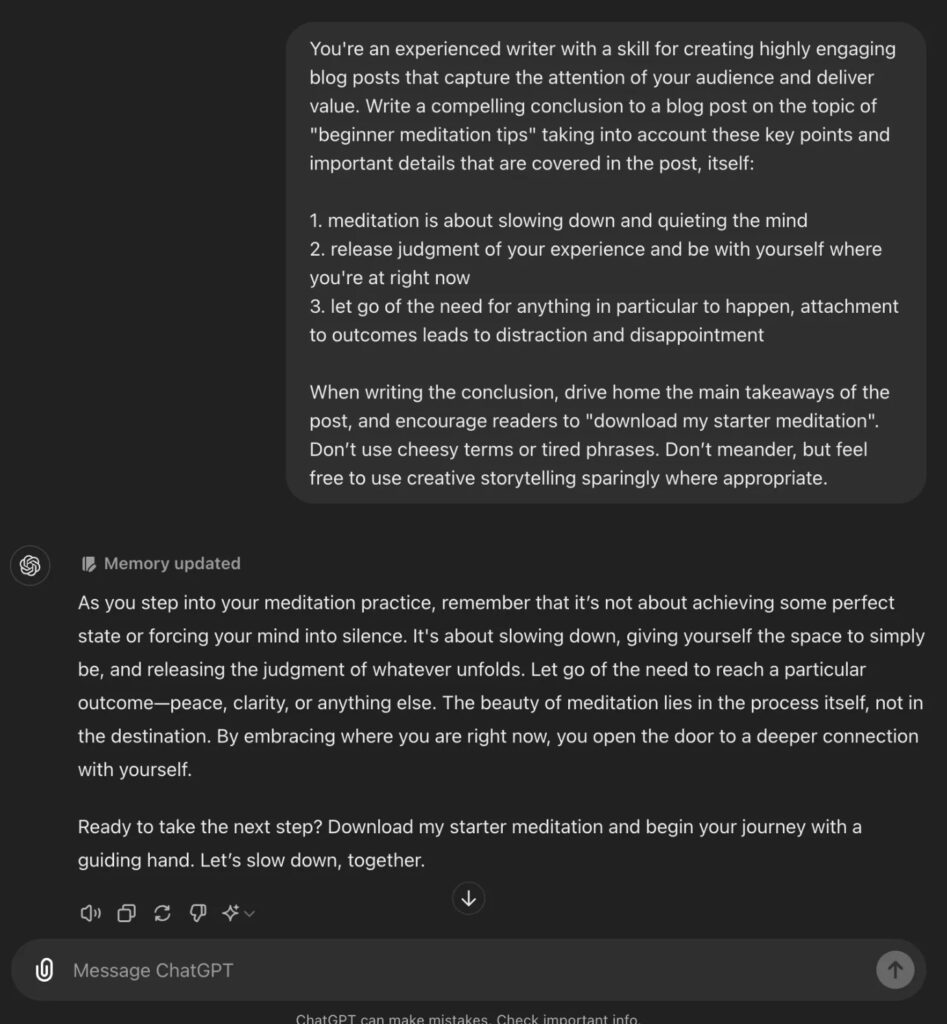

Craft compelling conclusions in just a few clicks with my free blog conclusion generator.
3. Outlines
Let’s say you have the right blog post idea already loaded up and ready to go… but you’re not so sure about all the details the article should cover. I recommend outlining as much of an article from your own base of knowledge & experience when you can—but in those times when you could use a little inspiration, this ChatGPT prompt for writing an outline, will give you some fantastic starting points to consider.
You’re an experienced writer with a skill for creating highly engaging blog posts that capture the attention of your audience and deliver value. Create an outline for blog post on the topic of [TOPIC—BE AS DETAILED AS POSSIBLE] for an audience of [AUDIENCE DESCRIPTION]. When drafting the outline, take into account my key point of view [YOUR QUICK TAKE ON THE TOPIC] to inform the framing and crucial sections to include in the outline. Gather inspiration from other successful articles on this topic to make sure we’re not leaving out any important points and sections. Use SEO best practices to ensure proper use of keywords in headings.
Here’s a preview of what you can expect with this ChatGPT prompt for writing article outlines:
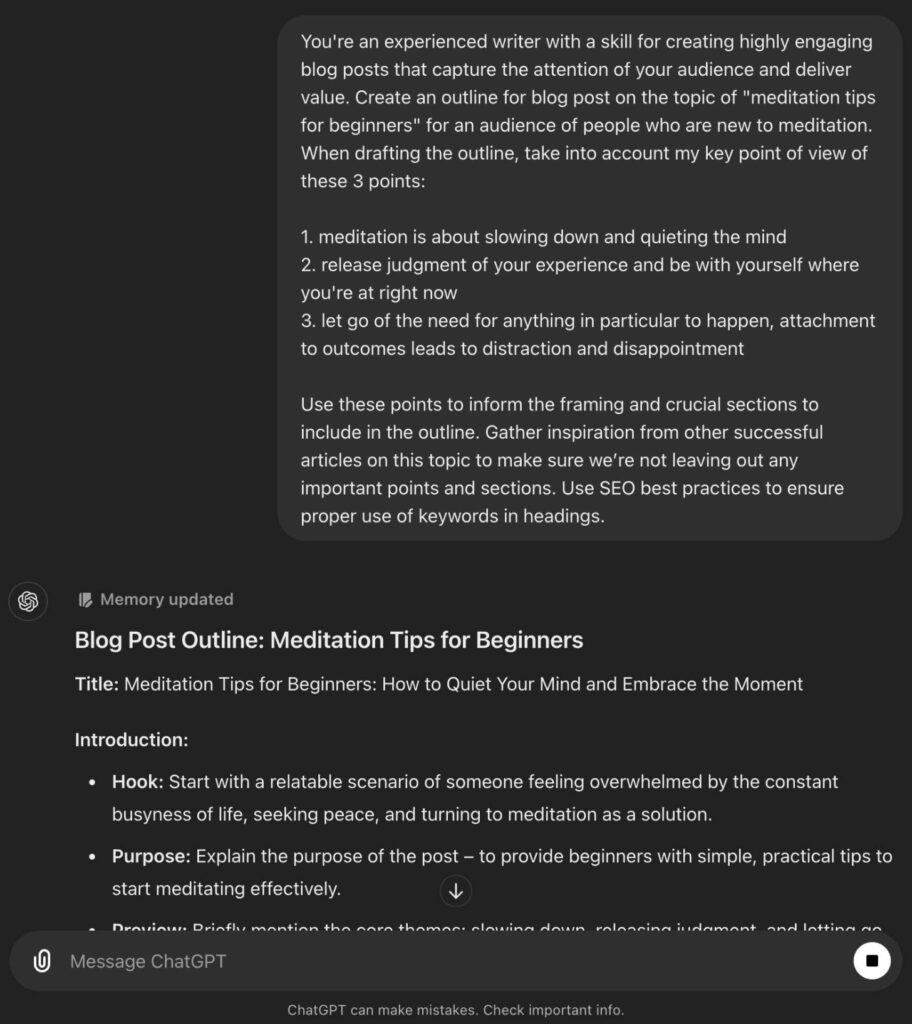

Create full outlines for your articles using my free blog outline generator tool.
4. Sections of Articles
Another great use case for AI tools like ChatGPT, is in creating smaller chunks of content (think paragraphs and header sections), that take your stance on a particular topic, then expand a bit—giving you more to work with and weave into your articles.
You’re an experienced writer with a skill for creating highly engaging blog posts that capture the attention of your audience and deliver value. Write a section of a blog post on the topic of [SPECIFIC SECTION OF A POST—BE AS DETAILED AS POSSIBLE]. This is for an audience of [AUDIENCE]. Don’t use cheesy terms or tired phrases and don’t meander.
Using this ChatGPT prompt to write sections of your content, here’s an example of what you can expect:
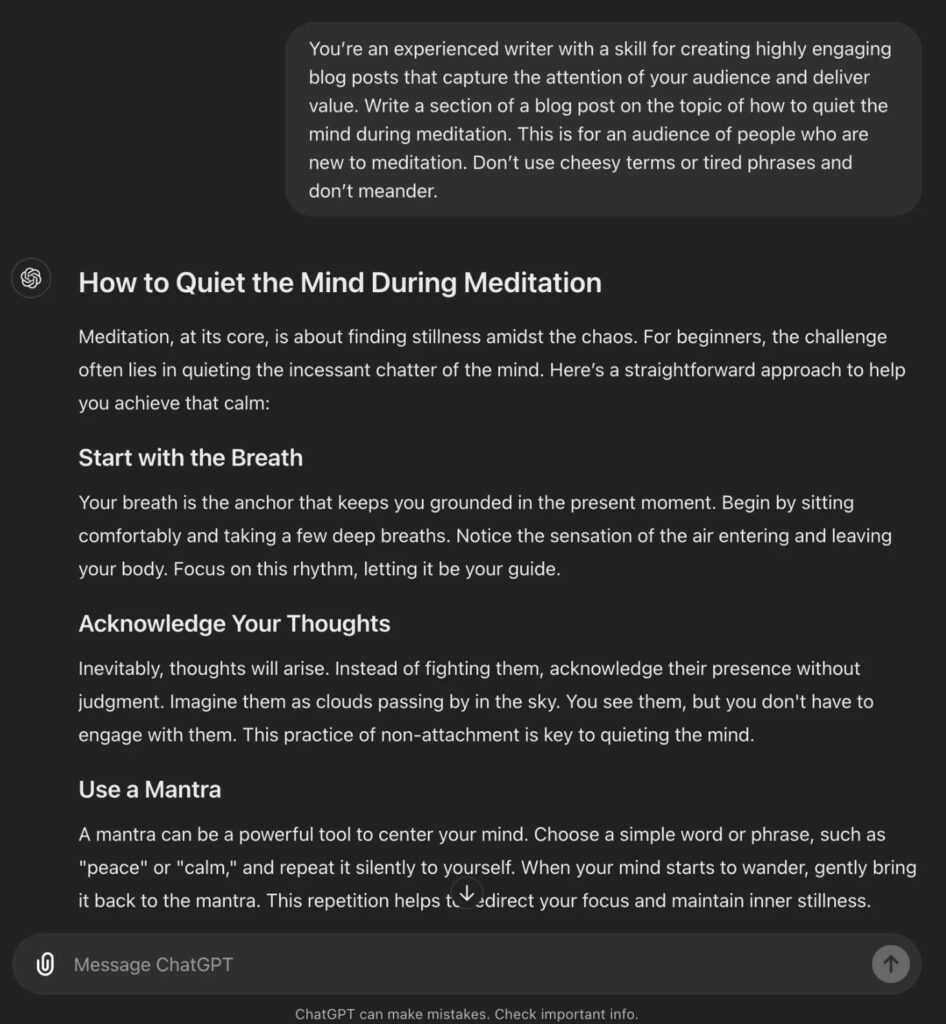

Take my free Paragraph Generator tool for a spin, to speed up this process.
5. Full SEO-Optimized Articles (First Drafts)
Ah yes, writing full SEO-optimized articles using ChatGPT. I knew why you were really here.
I have an entire guide to my personal AI blogging process that goes deeper on my thoughts around how to best utilize tools like ChatGPT and RightBlogger to write blog posts with the help of AI—but the key takeaways are two things:
- Treat AI-generated blog posts as first drafts: We’ve all seen the imperfection of AI on full display more times than we can count, and nothing is more true than if you give AI very little direction to work with, it’s going to be wildly unpredictable in its output. The more guidance you give it (in the form of a detailed prompt), the better your first draft will be, but it’ll always be a first draft, because…
- Weave as much of yourself & your take into the creation process as possible: AI doesn’t have a lived body of human experience, it can’t draw on the real examples inside your head, and it won’t be able to tap into your human emotion. It’s an imitation of all these things, and in that sense it’ll always be non-human. Full articles from sources like ChatGPT and RightBlogger can be pretty impressive, but they still need your editing, your style, real-life examples, stories, and personal experiences.
The first step to writing an SEO-optimized first draft article that uses real-time Google search data, is crafting a great outline.
Step 1: Generating a detailed, SEO-forward outline for ChatGPT to use as a foundation.
You’re an experienced writer with a skill for creating highly engaging blog posts that capture the attention of your audience and deliver value. Create an outline for blog post on the topic of [TOPIC—BE AS DETAILED AS POSSIBLE] for an audience of [AUDIENCE DESCRIPTION]. When drafting the outline, take into account my key point of view [YOUR QUICK TAKE ON THE TOPIC] to inform the framing and crucial sections to include in the outline. Gather inspiration from other successful articles on this topic to make sure we’re not leaving out any important points and sections. Use SEO best practices to ensure proper use of keywords in headings.
Here’s step one of writing a full article draft using ChatGPT, focusing in on creating a great outline first:
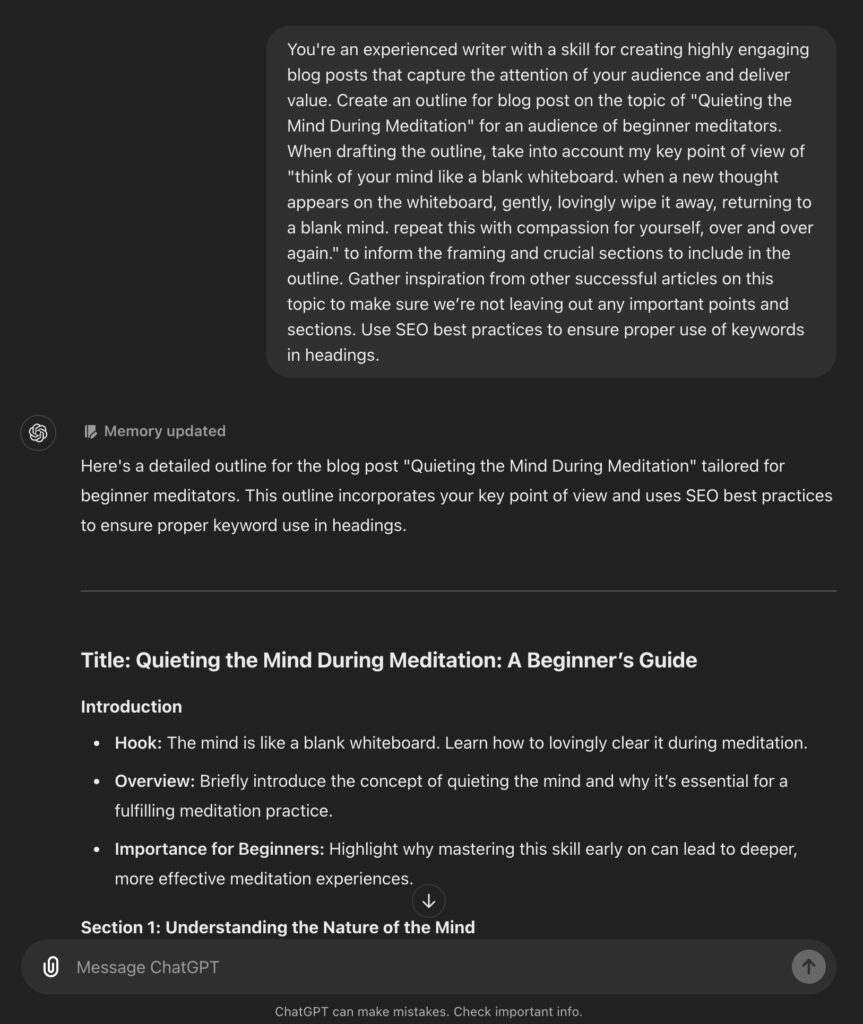

Step 2: Make edits to refine your outline.
Interact with ChatGPT to make any necessary edits and revisions to the outline you’ve created.
Please don’t skip this step, it’s crucial to making sure you’re injecting your take, beliefs, style, personality, and experience into the AI writing process. Without you, I can promise your ChatGPT outputs will sound more like AI and be a total pain to level up during your editing process.
Step 3: Write the full first draft of your article using the dialed in outline you’ve created.
Write a 1,500 word (minimum) article using the outline above, taking into account the same audience, topic, and tone guidelines. Use list formatting as much as possible, where appropriate. Structure the format of the article for maximum scannability and readability. Gather inspiration from other successful, high-ranking articles on the same topic.
And here we go—a preview of what ChatGPT’s doing with this prompt. Not bad, but could use a whole lot of love in the formatting department:
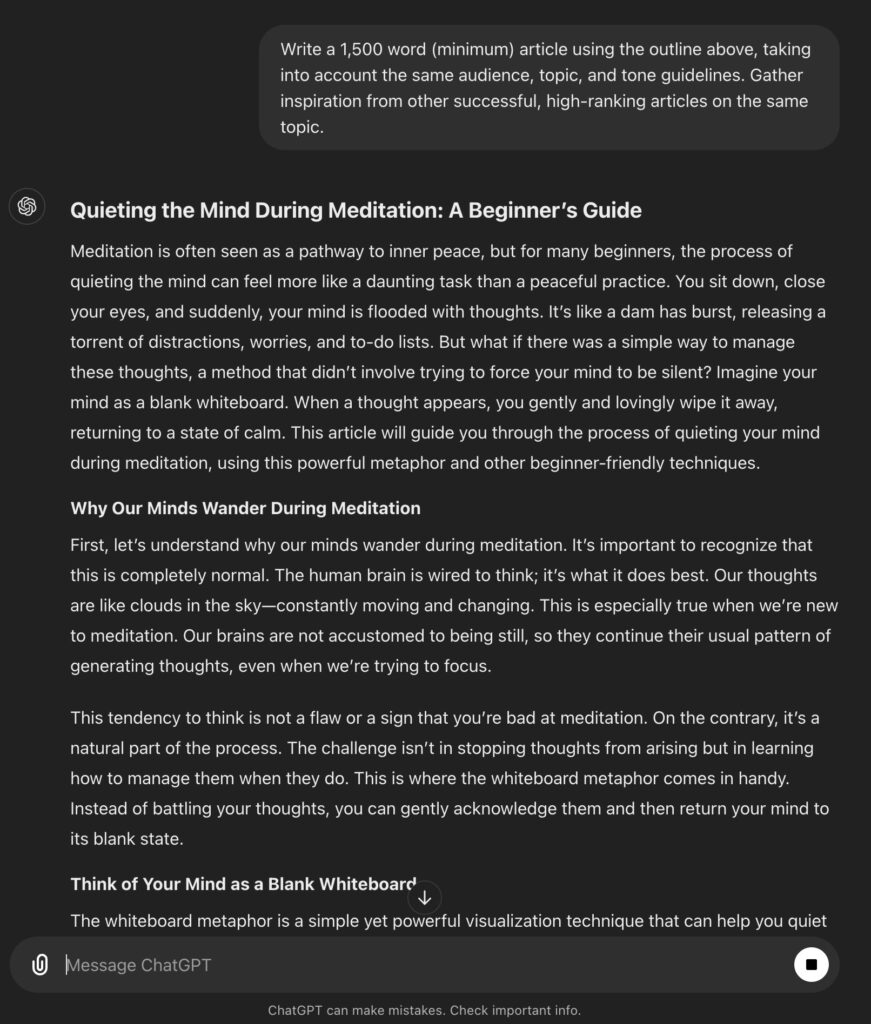

This is kind of a lot, I know. Simplify your AI writing experience by using my free AI article writer. For a super-powered version of this tool, you’ll wanna use RightBlogger’s Article Writer, where we’ve really dialed things up about a hundred notches.
Try RightBlogger: My 75+ Hand-Crafted Tools for Bloggers


Join 4,516+ creators, bloggers, marketers, writers, freelancers & entrepreneurs in using my very own kit of powerful tools for content creation: RightBlogger. You’ll unlock 75+ blogging, SEO, marketing, sales and productivity-focused tools to create content faster & more effectively today.
If you dig these ChatGPT writing prompts, you’ll find even more in my roundup of all my top ChatGPT prompts for bloggers, too.
6. FAQs (Frequently Asked Questions)
Researching the most frequently asked questions on a topic you’re considering writing about, is one of the best ways to create genuinely helpful content that real people are already searching for answers about. Use this ChatGPT writing prompt to get the best FAQs (and their answers) in seconds:
You’re an experienced writer with a skill for creating highly engaging blog posts that capture the attention of your audience and deliver value. Create a short list of all the most frequently asked questions about [TOPIC—BE AS SPECIFIC AS POSSIBLE]. Include the answers to each question, be sure to cover a minimum of 5 and maximum of 10 FAQs. Present the list of questions and answers in an SEO-friendly format with the question in H3 and answer in paragraph format. Use list formatting as much as possible, where appropriate. This is for an audience of [AUDIENCE]. Don’t use cheesy terms or tired phrases and don’t meander.
Here’s what you can expect from this ChatGPT prompt for writing relevant FAQ content:
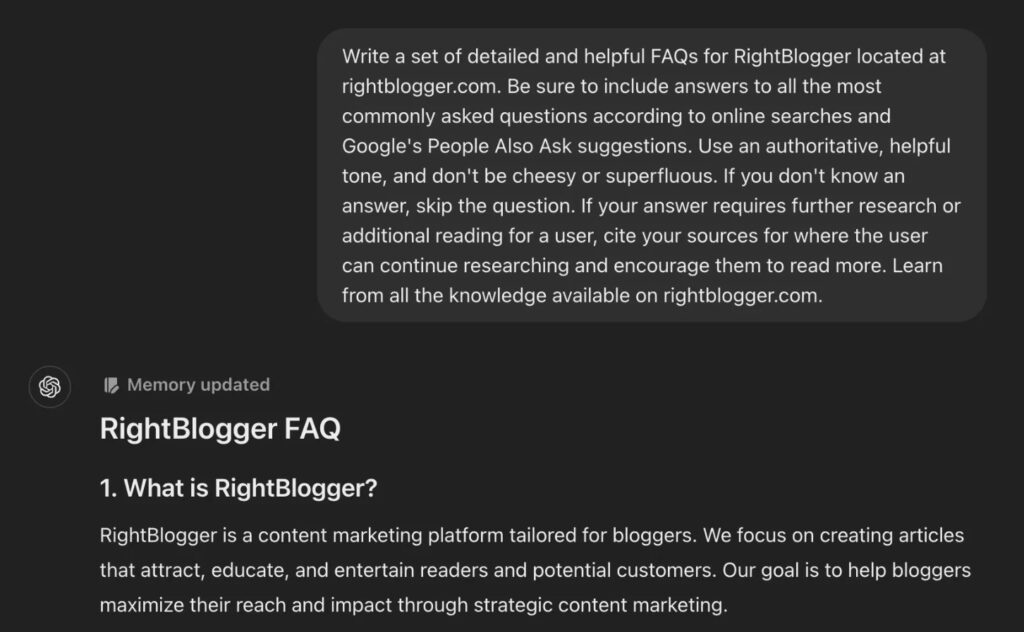

We built an FAQ Generator Tool inside RightBlogger that’ll quickly source the most relevant key questions related to your topic, and provide helpful answers, too. Just be sure to double check everything is lookin correct—we know AI sometimes has a mind of its own.
Ideation and Planning ChatGPT Writing Prompts
For me, when great ideas are flowing, they usually come in huge waves and I do my best to capture all of them—even if it’s in the form of a quick audio note or jotting them down in my creative journal if I’m away from my studio.
Yet other times, I can feel totally uninspired. It’s a crazy hot & cold thing sometimes, being a creator.


In times of need, I’m a big fan of turning to tools like ChatGPT to stock me back up with potential ideas and plans for shaking myself out of a creative funk. Here are my favorite prompts for just such occasions.
7. Article Ideas
When your content calendar is running low, and you’re not feeling particularly creative, try using ChatGPT as a tool to spark your fire again. Here’s my ChatGPT prompt for getting a crop of new article ideas within my niche:
You’re an experienced content marketer. Propose 25 new article ideas about [SUBJECT] that haven’t been covered on [YOUR WEBSITE URL] and tailor these ideas to our audience of [DESCRIBE YOUR AUDIENCE]. These article ideas should include a mix of formats and angles including how-to, what is/are, mistakes to avoid, tutorials, reader questions, listicles, reviews, where-to, why, how I, questions, challenges, and lessons learned post types. Keep in mind, the goal of these articles will be to attract, educate, and entertain readers and new potential customers related to our business.
Here’s what a slightly tweaked version of ChatGPT ideation prompt looks like in action (you’ll get very similar results):
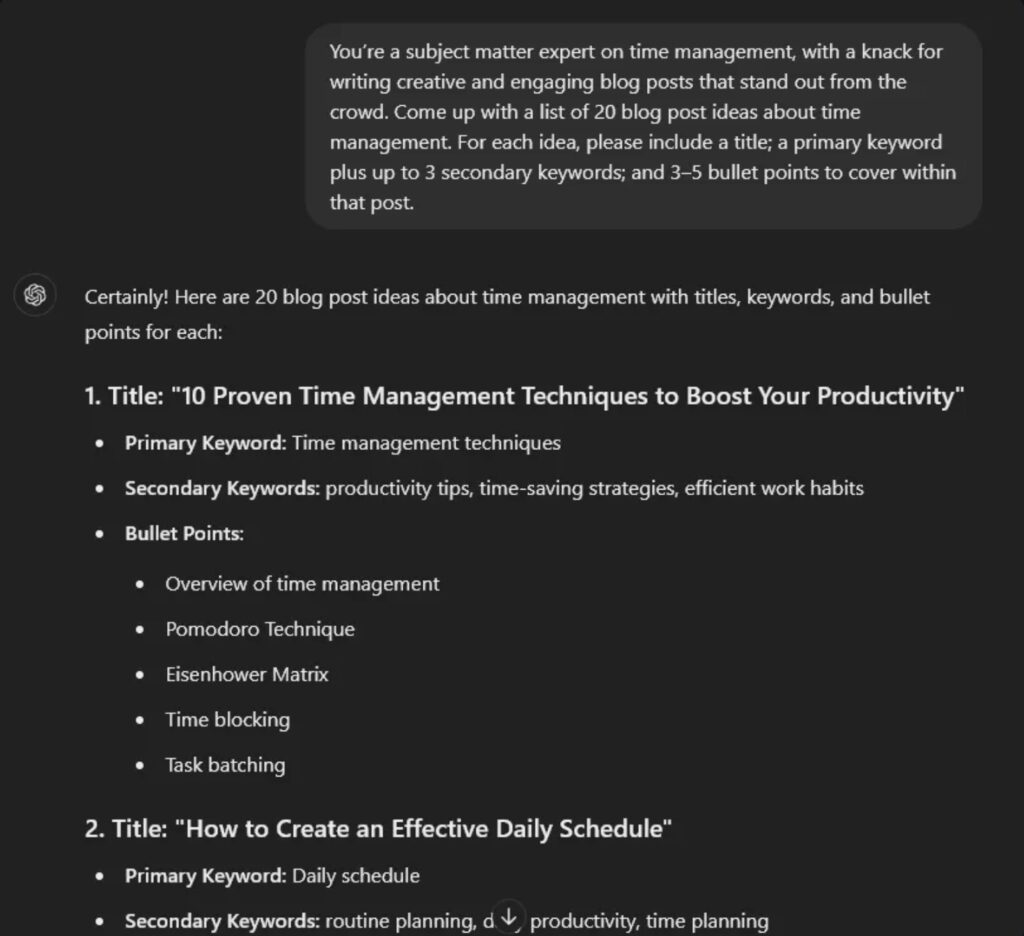

Try my free blog post idea generator to get a jumpstart on your brainstorming process in just a few clicks.
8. Content Plan + Publishing Schedule
Knowing what you’re going to publish, and when, is a great practice to keep once you’re running a content-fueled business that shows a clear ROI for your time spent creating great content. Here’s my ChatGPT prompt for creating a content plan (aka publishing schedule):
You’re an experienced content marketer with a knack for creating highly engaging, educational, entertaining content in a variety of formats for your brand [COMPANY/BRAND NAME AND DESCRIPTION]. Create a 1 month-long content publishing schedule with a focus on summer festivities, specifying which days and times to publish a mix of blog posts, videos, and podcast episodes on our web property & social channels for maximum engagement. Include a mixture of recommendations for different content types and blog post types, designed around driving audience discussions, inspiring engagement, educating our customers, asking questions, and others you recommend based on brands successfully creating content in the [OUR INDUSTRY] industry. Include a few examples for all post types you recommend.
Here’s one example of what this ChatGPT content planning prompt looks like in practice:
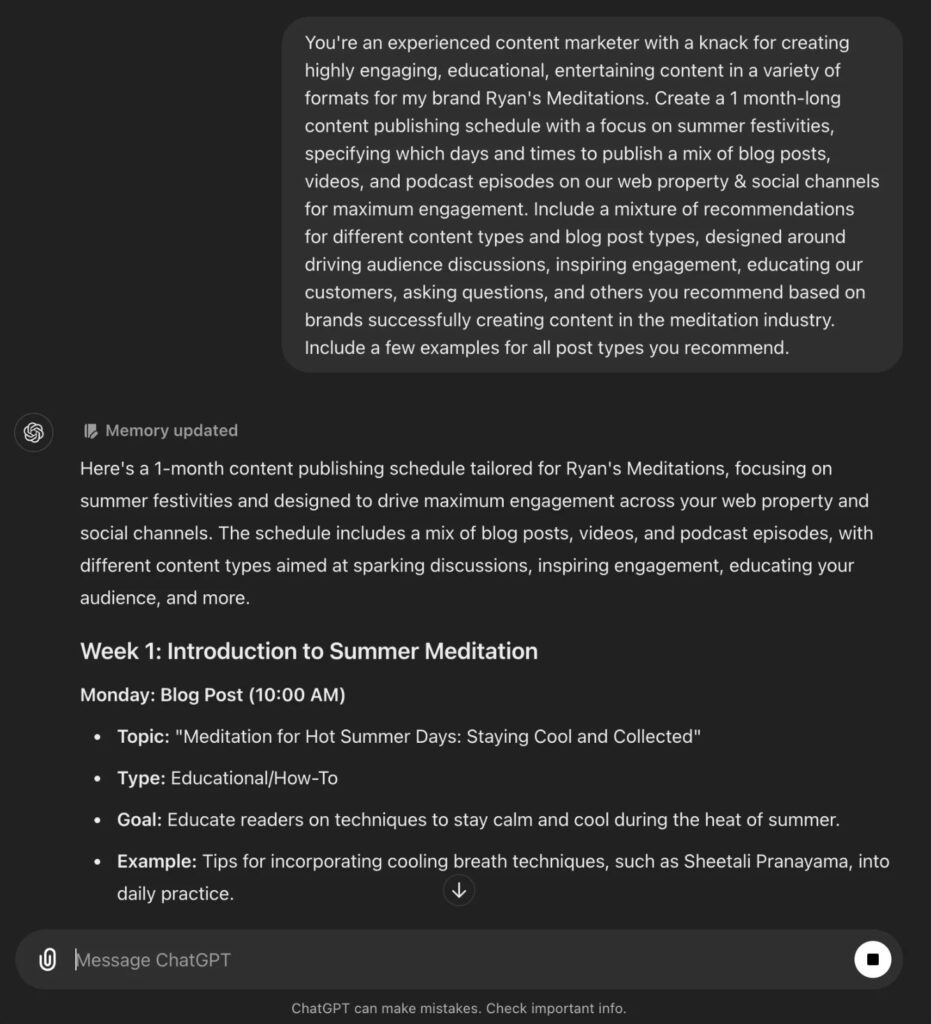

Now, let’s dive into using ChatGPT for research and identifying opportunities where you could create content that’ll attract an audience.
Research and Opportunity Identification ChatGPT Writing Prompts
If you think you can do more research than AI models that are trained on virtually the entire Internet, then I’d like to be your friend. For the rest of us, we now have ChatGPT to help with more targeted research.
Perhaps one of the top areas where AI writing tools like ChatGPT and RightBlogger really stand out, is in conducting research to figure out the absolute best, audience-informed topics for you to create content about.


Not knowing how to properly research is a common challenge in your early writing days. The right ChatGPT prompts can help activate this powerful assistant and help you maximize your researching time investment.
9. Keyword Research
There’s an entire art and science to doing keyword research, but in the world of AI, you can get some really fantastic, actionable insights from the right ChatGPT prompt. Here’s mine:
You’re an experienced SEO professional. What is the estimated monthly search volume for [KEYWORD PHRASE]. Reference multiple sources to come up with a realistic, current range. If you don’t have a clear estimated search volume range, do not make your answer up. Give me a sense of how competitive it will be to rank in organic search engine results for this keyword phrase.
Here’s what this ChatGPT prompt for keyword research looks like, in action:
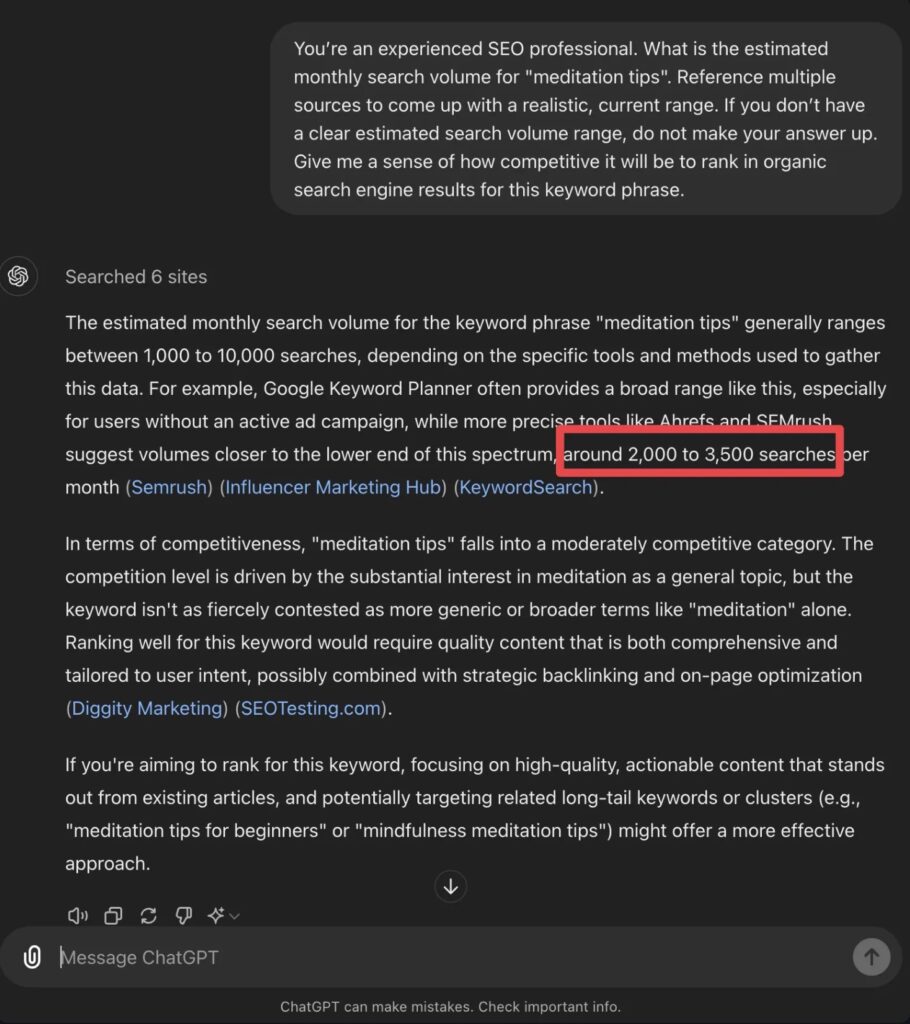

My free keyword research tool has quickly become one of the most popular in my stable of free blogging tools. Take it for a spin to simplify your keyword research process today.
10. Keyword Clusters
Keyword clusters are a group of related keywords that all have some topical overlap and often, similar search intent. Creating a keyword cluster is a brilliant way to approach mapping out a content strategy that has the potential to rank your writing for tons of terms in your niche. Here’s my ChatGPT prompt for keyword clustering:
You’re an experienced SEO pro and content marketer that’s highly skilled at mapping out and executing on a strategic content plan that’s designed to drive organic traffic from search engines and other sources. Create a detailed keyword cluster map for the topic [TOPIC] geared toward an audience of [AUDIENCE]. Group the individual keyword/topic suggestions within their corresponding relevant categories. Be sure to include a minimum of at least 5 base categories with a minimum of 5 to 10 suggested keywords within each category. Include corresponding estimated monthly search volume and level of difficulty to rank for each keyword phrase. Only give research-backed suggestions that have a high likelihood of traffic driving potential. If you don’t have a clear estimated search volume range for a keyword, do not make your answer up. Give me a sense of how competitive it will be to rank in organic search engine results for each keyword phrase.
Here’s what this keyword clustering prompt looks like inside ChatGPT:
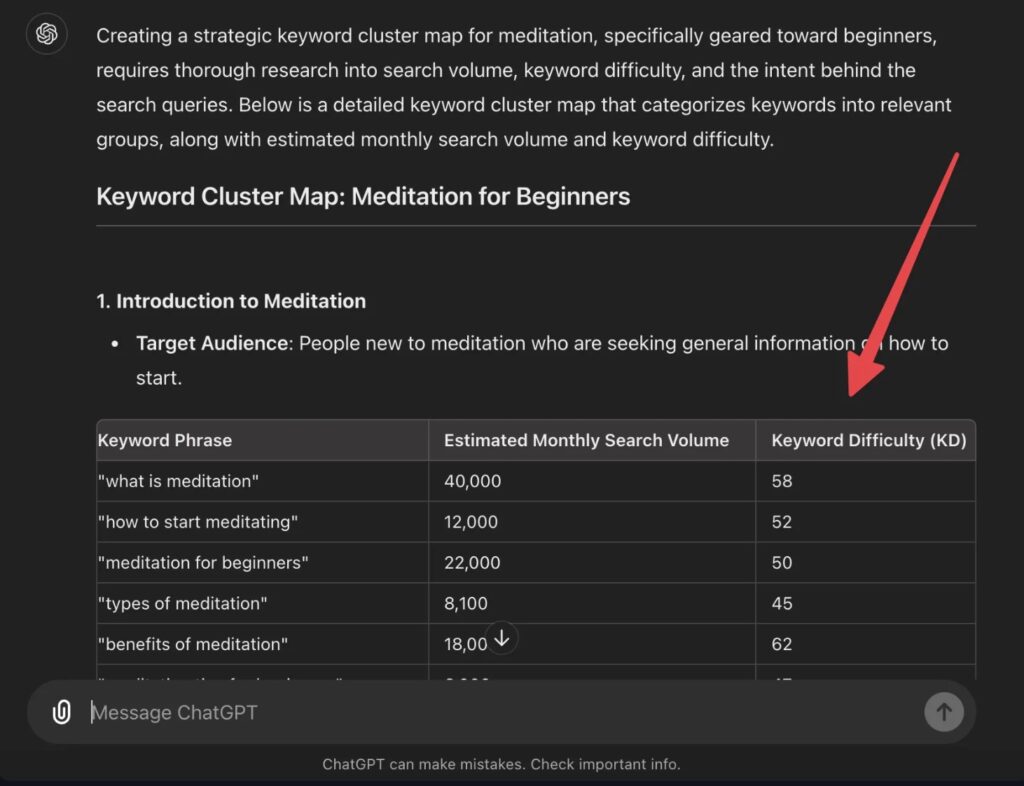

Dig this one? I made a free keyword cluster tool, because I love cluster mapping so much. I think you’ll love it, too.
11. Long-Tail Keywords (People Also Ask)
Now for one of my favorite content research secret weapons—the People Also Ask section of Google search results:
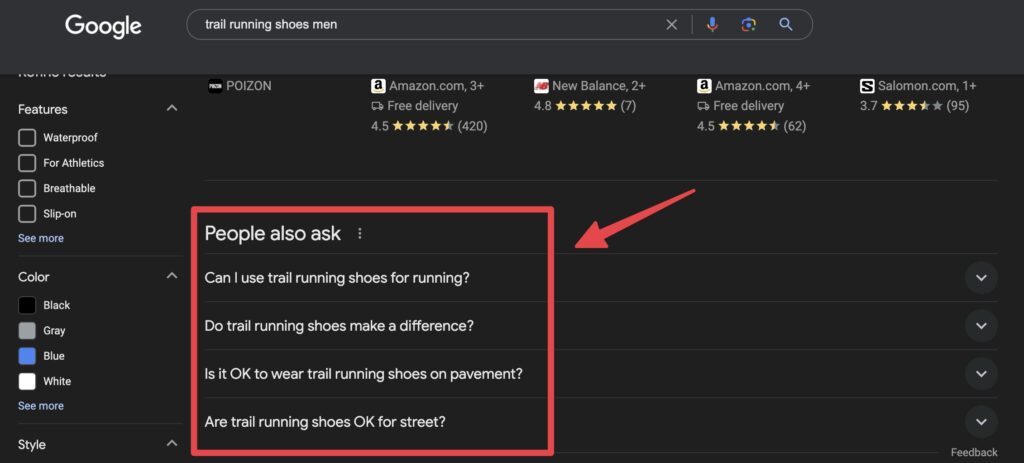

Literally all 4 of these topics would make FANTASTIC articles & videos for a creator in the running or hiking space that wants to earn from affiliate programs. Sheesh, I wish I had more free time…
Anyway, AI tools like ChatGPT and RightBlogger have access to real-time Google search data, so they can quickly perform a search and list out all the most relevant long-tail keyword topics that real people are searching for online—giving you some of the richest, least competitive content ideas to get working on.
You’re an experienced SEO pro and content marketer that’s highly skilled at mapping out and executing on a strategic content plan that’s designed to drive targeted organic traffic from search engines. Create a list of People Also Ask questions & answers for the topic [TOPIC] for an audience of [AUDIENCE]. Only give research-backed suggestions that have a high likelihood of traffic driving potential. If you don’t have a clear estimated search volume range for a keyword, do not make your answer up. Give me a sense of how competitive it will be to rank in organic search engine results for each keyword phrase.
Here’s what you can expect with this People Also Ask ChatGPT prompt:
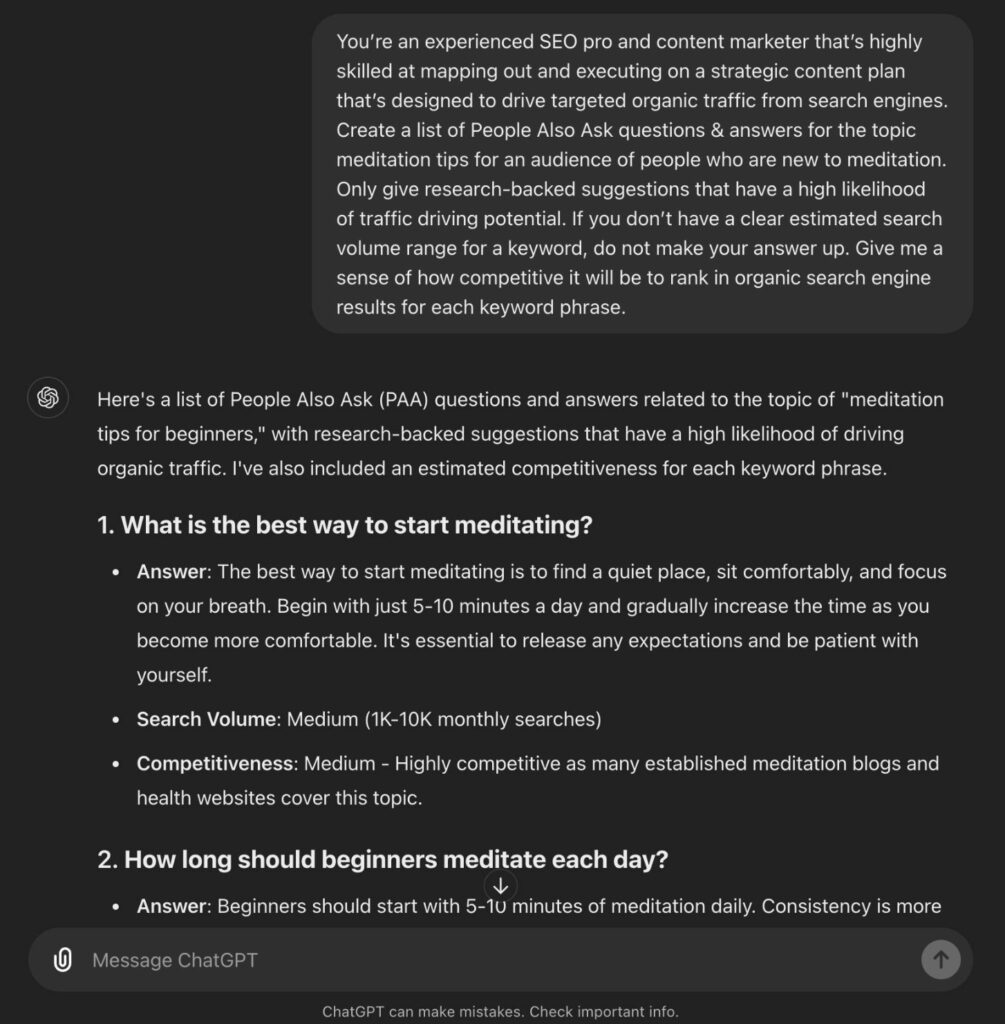

Try RightBlogger’s People Also Ask Tool to instantly source long-tail keyword opportunities and get fantastic starter copy to answer those questions in content for your site.
Once you’ve created your content, there’s still a whole lot more that goes into growing a successful business around your writing.


These are my favorite ChatGPT prompts for everything from SEO-optimization, to promoting my writing, and repurposing it for different formats & platforms.
12. SEO-Optimize Your Writing
SEO (search engine optimization) is the process of thoughtfully finding the balance of writing for humans & search algorithms at the same time. It’s a far more in-depth process than we can cover here, but it essentially helps you tune up an article you’ve written—in a way that gives it the best possible shot at ranking high in Google search results.
This is the ChatGPT prompt I use for optimizing an article that’s already published. Alternatively, if you have the copy from your working draft, you can paste that into ChatGPT and get the same analysis.
You’re a veteran blogger and SEO professional with deep experience in optimizing content to rank high in organic search results. Create a shortlist of actionable optimizations to this post [ARTICLE URL] that will help it rank higher in organic search. Take inspiration from other top-ranking content for the topic [PRIMARY KEYWORD PHRASE] and suggest clear improvements based on what’s working well with current top-ranking results. Don’t copy or imitate the other articles, use them for inspiration and insights only.
Here’s that AI prompt, in action over inside ChatGPT:
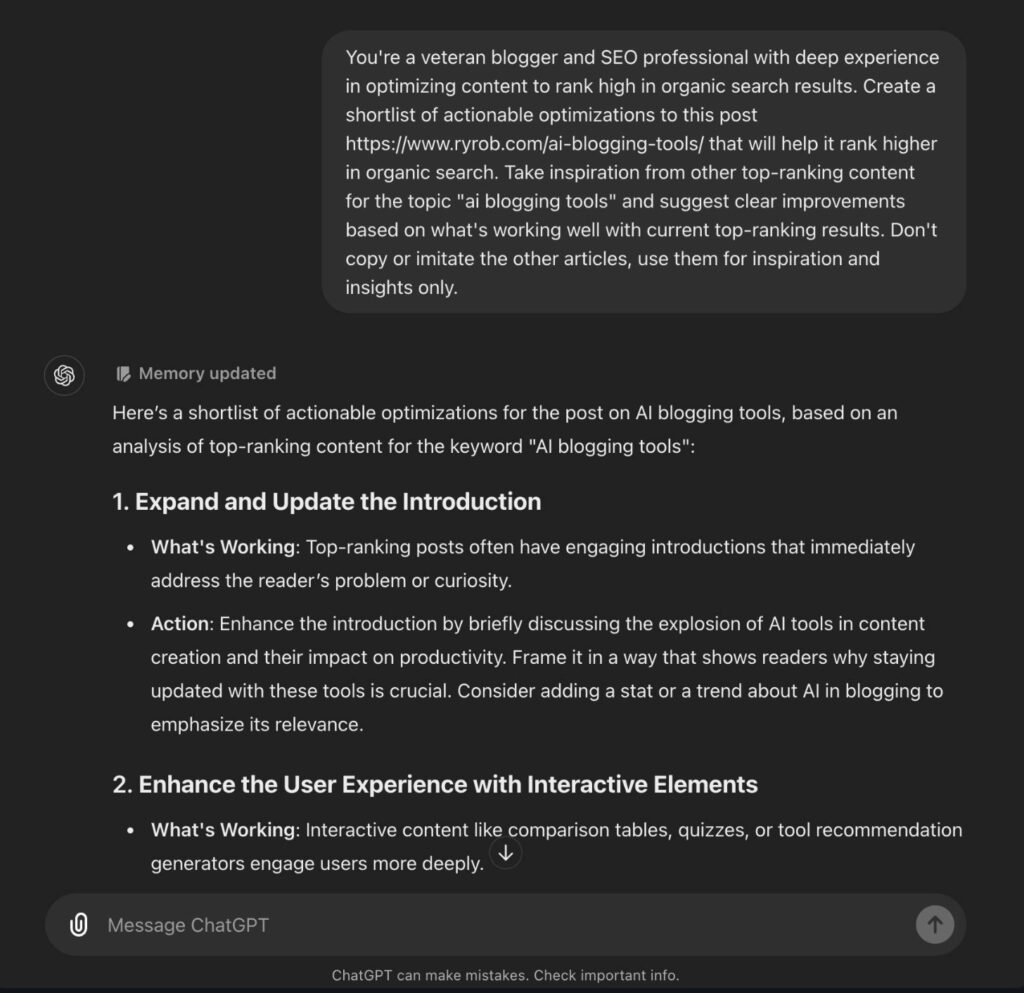

You’ll still need to take action on the SEO-optimization suggestions, but you can sleep real good at night knowing these insights come from a deep well of ‘knowledge’ about what Google will rank high in their search results.
13. LinkedIn Posts
I try and post to my LinkedIn at least a few times each week, but sometimes I go literally months without sharing updates or weighing in with my take on something that’s going down in the content creation space. This ChatGPT prompt for writing LinkedIn posts is super helpful in those moments when I’m not feeling inspired.
Compose 10 potential LinkedIn updates for [PERSON] discussing [TREND, EVENT, TOPIC, ETC] in [YOUR INDUSTRY]. Use a mix of post types, designed to engage LinkedIn followers who care about our industry. Be sure to include commentary on why each post is likely to be successful at engaging an audience.
Here’s an example of what you can expect with this ChatGPT prompt for writing LinkedIn posts:
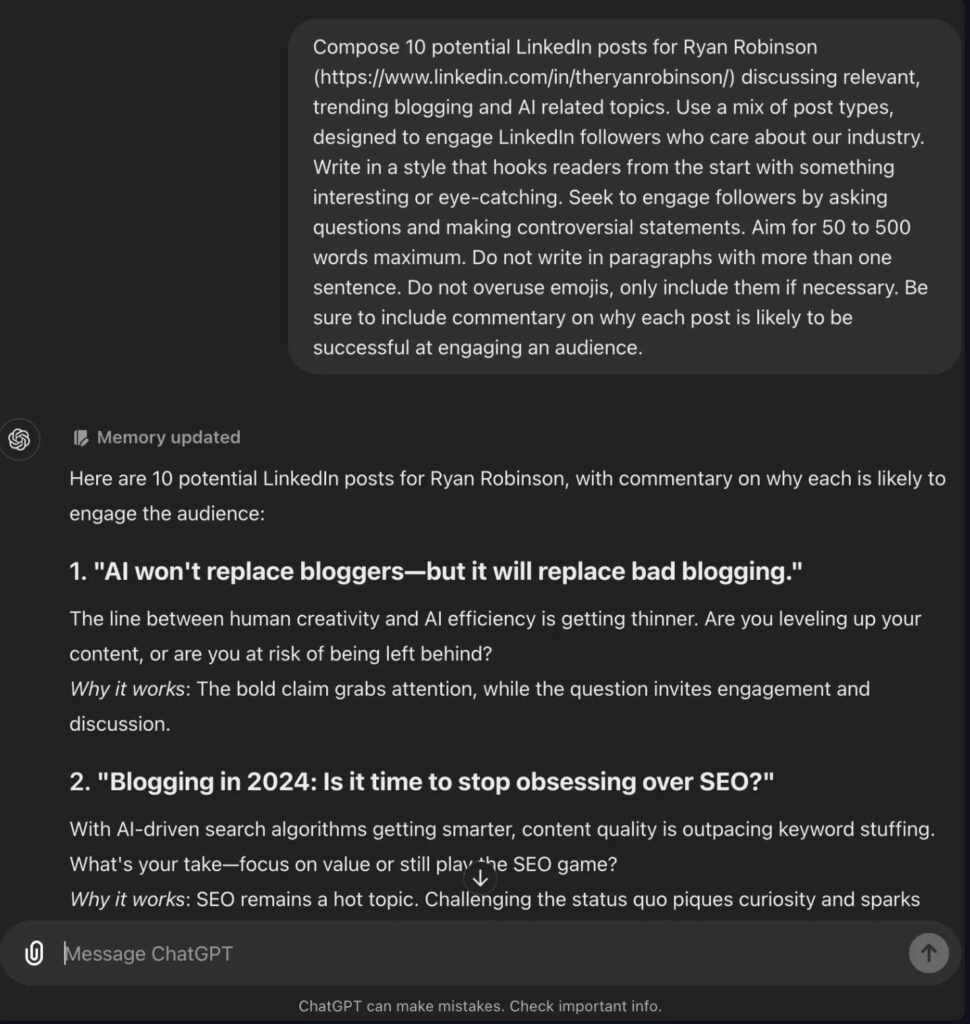

Take RightBlogger’s LinkedIn Post Generator for a spin with a free account, today.
14. Tweets (X) Posts
Same story, different platform for me. I used to spend a lot of time on Twitter, but these days, I don’t get as much personal joy out of social media—so when I need some ideas for what to share with my community, here’s the AI prompt I keep handy:
You’re trained as an experienced social media marketer. With a focus on driving interesting discussions or inspiring thoughts of checking out our product, draft a series of Twitter posts [TWEET TOPIC]. Don’t be cheesy. Write as if you’re a real human. Don’t overtly sell our product or brand, encourage followers to interact with the tweets.
Here’s this ChatGPT prompt for writing tweets, in action:
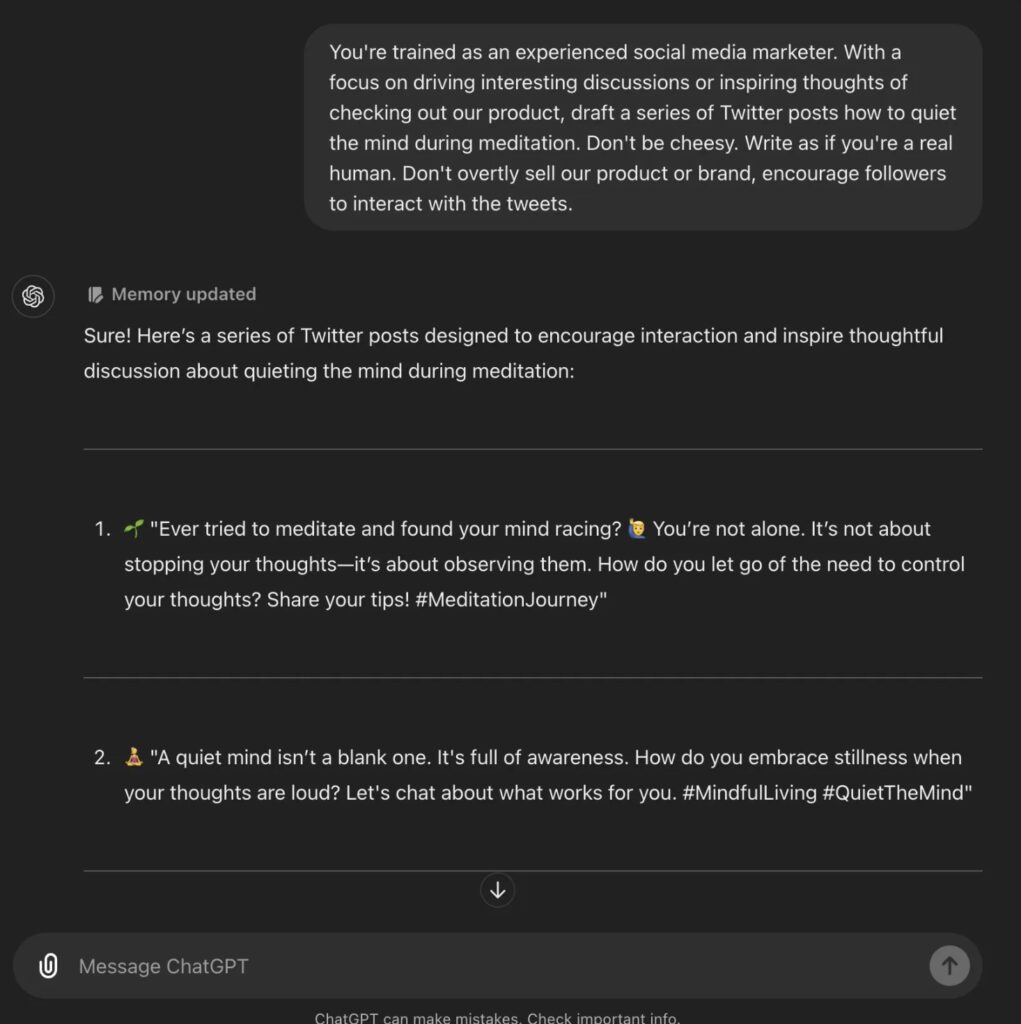

Take RightBlogger’s Tweet (X Post) Idea Generator for a spin with a free account, today.
15. Grammar and Spellcheck
There’s nothing wurse than hitting publish and having a few unnoticed typos or grammar mistakes sprinkled throughout your writing. Use this ChatGPT prompt for checking your grammar and spelling, in a snap:
You’re an experienced writer and editor with a knack for spotting spelling and grammar mistakes. Review the following text for spelling errors and grammar mistakes, providing accurate corrections. Make sure that all words are spelled correctly and flow naturally, making necessary adjustments to enhance the overall spelling and grammar accuracy of the text. [YOUR TEXT]
This one’s pretty self-explanatory, so no example image necessary—get your content edited & cleaned up by a powerful AI assistant.
Take my free grammar fixer tool for a ride today, and make your blog editing process even quicker.
16. Content Gap Analysis
Ever wonder why some articles outrank yours in Google search results and drive more traffic as a result? Well, it turns out AI tools like ChatGPT and RightBlogger (our Content Gap Analysis tool is sick), are absolutely fantastic at conducting this kind of analysis & reporting back with actionable takeaways to improve your writing in the eyes of search engines. Here’s my content gap analysis prompt:
You’re a veteran blogger and SEO professional with deep experience in optimizing content to rank high in organic search results. Create a shortlist of actionable optimizations to this post [YOUR ARTICLE URL] that will help it rank higher in organic search, by directly comparing it to this article that’s currently successful [COMPETITOR ARTICLE URL]. Take inspiration from this top-ranking content example for the topic [PRIMARY KEYWORD PHRASE] and suggest clear improvements based on what’s working well in this article. Don’t copy or imitate the other articles, use them for inspiration and insights only.
Here’s a preview of what this content gap analysis prompt will generate for you:
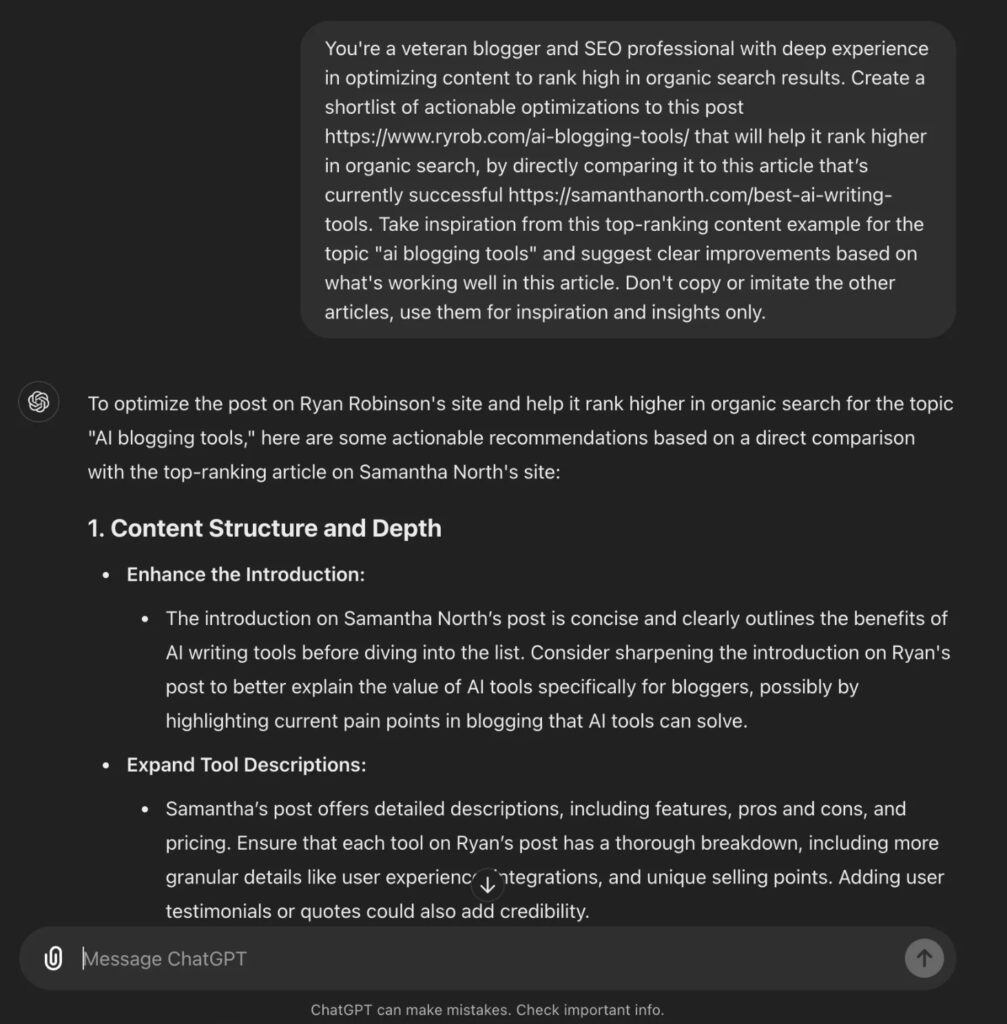

We have an even more powerful Content Gap Analysis tool inside RightBlogger that utilizes multiple different data sources and complex prompting. I know you’ll dig it if you give it a try.
My AI Writing Prompt Formula (to Get Better AI Outputs)
If snagging some good prompts is like being handed a fish, then learning the skill of prompt engineering and how to use ChatGPT like a pro, is like teaching yourself to fish. Oh, and you can even use DALL-E inside ChatGPT to generate unique stock images. Not bad…
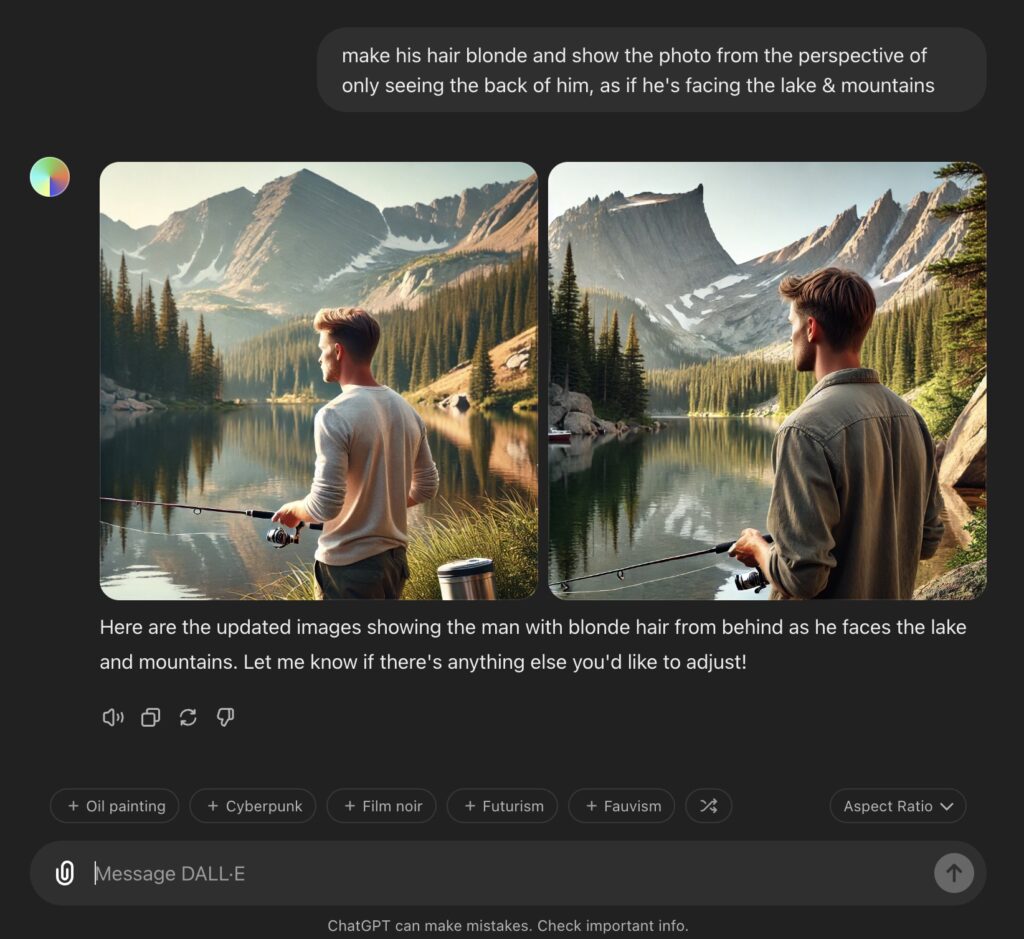

Learning to prompt is a skill, and a great investment in your future as a writer, to learn how to weave in powerful AI tools to your process where it makes sense for you.
Here’s my ChatGPT prompt formula that’ll significantly level up the outputs of any prompt you give it:
- Task: This one is straightforward. Tell the AI what you need. It could be writing an intro, drafting a blog post, or generating ideas.
- Context: Give as much background and detail as possible at this stage. The more specific you are, the better. Let the AI know details that are important to the task (like what your take is on a subject you’re writing about).
- Exemplar: Just a fancy way of saying “example.” Explain to ChatGPT exactly what kind of output you’re looking for. Including real examples will help it get closer to what you envision.
- Persona: Who should the AI “be” while writing this content for you? Imagine that AI can wear different hats for different tasks. Explain who it is within your prompts, and it’ll have a much better understanding of how to go about creating your output.
- Format: Share which format you want the final product to come in. What exactly should the AI output look like? Do you want a list, a paragraph, a blog post with multiple sections, maybe just some bullet points? Be specific here.
- Voice: Always define the style and tone when you’re writing a ChatGPT prompt. Do you want your output to be casual, formal, playful, something much more nuanced? Let these tools know, so your writing outputs will match your vibe.
If you can nail these elements at a high level within your ChatGPT prompts, then I can promise this AI prompt formula will serve you well.
Drop any questions or share your experiences with AI in the comments. Let’s help each other grow and write amazing content!
Try RightBlogger: My 75+ Hand-Crafted Tools for Bloggers


Join 4,516+ creators, bloggers, marketers, writers, freelancers & entrepreneurs in using my very own kit of powerful tools for content creation: RightBlogger. You’ll unlock 75+ blogging, SEO, marketing, sales and productivity-focused tools to create content faster & more effectively today.
Publisher: Source link

